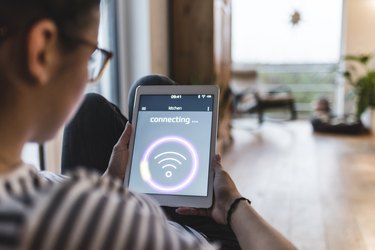
Wireless local area networking, also known as WLAN or wireless LAN, is a term for using wireless digital signals to connect computers and other devices. One of the most common wireless LAN technologies now in use is Wi-Fi, which refers to a set of standards for how devices can talk to each other on wireless networks. It's not the only wireless LAN technology out there, but it's the one you're most likely to encounter.
Understanding Wireless LAN Technology
Video of the Day
When you hear the term "wireless," it doesn't necessarily mean a device with no wires at all. The word originally applied to radios, which were often plugged into the wall or wired to batteries and also had wires internally.
Video of the Day
Rather, the term means that the devices communicate without needing to be wired together. Radio was originally a wireless alternative to the wired telegraph, and wireless phones began as alternatives to traditionally wired landline phones.
In the context of computers and smart devices, wireless means that they can talk to each other digitally without having to be connected with wired technologies like Ethernet cables or dial-up modems that speak across the landline phone system. A local area network, or LAN, is any system that allows digital devices in a small geographic area, or even inside a building, to talk to each other. Many LANs nowadays are also connected to a wide area network and often ultimately to the internet.
A wireless LAN is any network that lets computers talk to each other without having to be wired to each other. This can be useful for reducing clutter in a home or office and for making it possible to move devices like smart phones and laptops around without loss of network connections or having to stretch wires from place to place.
LAN and Wi-Fi
One of the most common ways to build a wireless LAN today is using Wi-Fi. That refers to a set of standards, related to the Electrical and Electronics Engineers set of standards beginning with the number 802.11. Different Wi-Fi standards can be referred to by their 802.11 standard number, such as 802.11b or 802.11g, or by other more conversational names like Wi-Fi 6 or Wireless G.
Generally, in both home and office Wi-Fi networks, devices called access points listen for connections from computers in the area. These are often also routers, which can effectively direct traffic across the local area network and to and from the internet. Routers often support multiple versions of the Wi-Fi standards so they can support multiple generations of devices, but if you're setting up a network, you should make sure all your devices will be compatible with it.
Most modern laptops and cellphones support Wi-Fi, and you can check the box your device came in or its documentation to see what versions of the standard it works with. You can buy an external adapter if you need to talk to another kind of Wi-Fi network.
Other Wireless Technologies
Wi-Fi isn't the only wireless LAN technology. The first is usually considered to be AlohaNet, which was created to network computers at the University of Hawaii in the 1970s. Since then, a number of other wireless standards have been developed, though they've essentially been eclipsed by Wi-Fi.
One other wireless system currently in wide use is Bluetooth, although it's usually used to create a paired connection between two devices rather than a broader LAN. When computers, tablets and smart phones communicate with cellphone towers to get internet access, they also use wireless communication technology, though they also don't usually form a LAN other than through a local Wi-Fi setup.